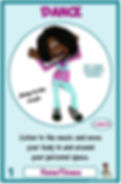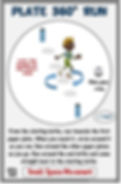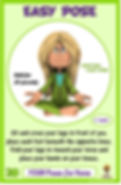Engaging At-Home PE Activities for Effective Distance Learning in Physical Education
- Pete Charrette
- Jan 23, 2024
- 13 min read
Updated: Jan 31, 2024
In an era where distance learning and at-home education have become increasingly prevalent, the role of physical education has evolved yet remains fundamentally vital. Physical education, traditionally known for its structured classes in the confines of a gym or oversized classroom, now faces the challenge of adapting to remote and home environments. However, this new setting brings a unique opportunity to underscore the importance of physical activity, not just for physical well-being but also for mental health and overall skill development. In the confines of a living room, backyard, or a small apartment space, physical education can be a dynamic tool to keep students engaged, active, and learning. It serves as a crucial outlet for energy, a mechanism for stress relief, and a platform for teaching valuable life skills such as self-discipline, goal-setting, and personal responsibility.

This article aims to provide physical educators with a suite of creative, fun, and easily accessible physical education activities tailored for at-home implementation. Recognizing the constraints and challenges of home environments, these activities are designed to be versatile, requiring minimal equipment and space, while maximizing student engagement and fitness/skill benefits. From fitness-based exercises to yoga poses, each activity is chosen to cater to a wide range of student needs and preferences, ensuring that every child can participate and benefit. Alongside these activities, I'll share tips and strategies to help educators effectively integrate these exercises into their online classes or as engaging homework assignments. The goal is to empower educators with the resources and ideas they need to continue delivering high-quality physical education, fostering a love for physical activity and a commitment to health, even outside the traditional school setting.
Fitness-Based Tasks for Students in their Homes
In this section, we explore a variety of engaging fitness-based tasks tailored for at-home physical education, ensuring students stay active and healthy during remote learning

Maintaining Fitness in Remote Learning Scenarios
Fitness is not just a physical endeavor; it's a holistic approach to well-being, crucial for students learning from home. The absence of traditional PE settings and routines can lead to a sedentary lifestyle, impacting both physical health and mental agility. In remote learning scenarios, maintaining fitness becomes not just an activity, but a necessary discipline to ensure students stay active, engaged, and healthy. Fitness tasks at home can serve as a catalyst for building resilience, improving concentration, and boosting overall mood — key factors in successful learning and personal development.
Specific Fitness-Based Tasks
Bodyweight Exercises: Introduce a series of bodyweight exercises such as push-ups, sit-ups, and lunges. These exercises don’t require any special equipment and can be easily adapted to various fitness levels. Use your visuals to demonstrate correct postures and sequences.
Jump Rope Challenges: A jump rope is a simple yet effective tool for cardiovascular fitness. Propose challenges like '100 jumps a day' or 'jump rope alphabet', where each letter represents a different jumping style. This can be a fun and engaging way to keep students motivated.
Flexibility (Static and Dynamic) Movements: Incorporating stretching routines help to improve students' flexibility while reducing their stress. Share easy-to-follow flexibility sequences and stretching routines, suitable for small spaces.
Circuit Training at Home: Design circuit training sessions that combine several exercises into one high-intensity workout. Circuits can include a mix of cardio, strength, and flexibility exercises, tailored to be done in limited space.
Dance and Movement: Encourage students to stay active with dance-based fitness. Choreograph simple routines or collaborate with students to create a 'class dance', fostering creativity along with physical activity.
Tips for Incorporating Fitness Tasks into Online Classes and Assignments

Structure and Routine: Create a weekly fitness schedule for students to follow. This provides structure and helps in setting clear expectations. This is especially effective for middle school and high school students to enhance learning.
Engagement and Interaction: Use online resources and tools like Google Classroom or Zoom to interact with students to implement virtual physical education classes. Live sessions for group workouts or posting recorded demonstrations can be highly effective for online learning.
Personalization and Adaptation: Recognize that each student's home environment and fitness level is different. Offer variations and alternatives to cater to diverse needs.
Feedback and Encouragement: Regularly check in with students to provide feedback. Celebrate achievements, no matter how small, to keep students motivated.
Family Involvement: Encourage students to involve family members in their fitness tasks. This not only adds a fun element but also promotes a healthy lifestyle for the entire family.
By integrating these fitness-based tasks into remote PE classes, we not only keep our students physically active but also engaged and motivated. It's about creating a culture of fitness that transcends the boundaries of the traditional classroom and enters the homes of our students, empowering them to lead healthier, more active lifestyles.
Tossing and Catching Tasks for Students at Home
Tossing and Catching Tasks for Students at Home focuses on accessible and enjoyable activities designed to enhance students' coordination and motor skills right in the comfort of their homes.

Enhancing Hand-Eye Coordination and Gross Motor Skills
Tossing and catching are foundational activities in physical education that significantly enhance hand-eye coordination and develop gross motor skills. These skills are essential not just for sports, but they also play a crucial role in daily activities and cognitive development. In a home learning environment, where students might have limited access to traditional sports equipment, it becomes even more important to find creative ways to maintain and develop these skills. Tossing and catching activities can be adapted to any space and can be performed with a variety of household items, making them ideal for at-home PE sessions.
Tossing and Catching Challenges - At-Home PE Activities
Sock Ball Toss and Catch: Create a DIY ball by rolling up a pair of socks, ideal for a safe indoor tossing and catching game. This activity helps students enhance their hand-eye coordination and agility in a confined space. They can practice tossing and catching the sock ball in various ways - 2 hand, 1 hand, clap and catch, under leg, behind back, from a foot, etc.
Playground Ball/Basketball Toss, Bounce & Catch: Utilize a playground or basketball (or any ball a student might possess around home) for a versatile activity that combines tossing, catching, and bouncing, challenging students to maintain control and accuracy in each movement.
Grocery Bag/Scarves Toss and Catch: Employ lightweight grocery bags or ultra light scarves for an imaginative catch challenge, where students can use one, two, or three bags to practice tricks and juggling maneuvers, developing their coordination and reflex skills. They can also move around in small spaces while tossing and catching the scarves.
Partner Toss and Catch: Invite students to involve a family member in a partner toss and catch exercise, using items like a rolled-up sock, a ball, or grocery bags, to promote interpersonal bonding and simultaneously enhance their catching and throwing skills.
Target Toss: Set up a target toss at home, where students aim to accurately throw an object at a designated spot, such as a laundry basket, trash bin or table top, to improve focus and precision.
Integrating Tossing and Catching in Virtual PE

Interactive Challenges: Host live tossing and catching challenges during your online virtual learning classes. Students can demonstrate their skills on camera, providing a sense of competition and camaraderie.
Skill Progression Assignments: Assign tasks that progressively increase in difficulty. Students can start with simpler activities and gradually move to more complex tasks, documenting their progress.
Use of Household Items: Encourage creativity by allowing students to use different household items for their activities. This not only makes the tasks more accessible but also adds an element of fun and innovation.
Family Participation: Involve family members by encouraging them to participate in these activities. This not only makes the activity more fun but also fosters a sense of community and support.
Feedback and Encouragement: Provide constructive feedback on the videos or live demonstrations. Celebrate achievements and offer tips for improvement to keep students motivated.
Adapt for Space and Safety: Always remind students to adapt the activities based on their available space and to ensure safety. For instance, softer objects like sock balls or balloons are safer for indoor use.
Incorporating tossing and catching tasks into at-home PE activities offers a unique opportunity to develop essential motor skills and coordination. With creativity and adaptation, these activities can become a fun and engaging part of the students' home physical education experience.
Small Space Movement Tasks for the Home Environment
In this section, we explore a variety of movement tasks specifically designed for small spaces, ensuring that students can stay active and develop key physical skills even in limited areas at home.

Overcoming the Challenges of Limited Space
One of the most significant challenges in at-home physical education is the constraint of limited space. Many students may not have access to large, open areas typically found in school gyms. However, limited space should not limit the opportunity to stay active. This section focuses on how to turn small spaces into effective arenas for physical activity, ensuring students can continue their physical development regardless of their environment. Adapting to confined spaces requires creativity and a focus on safety, ensuring movements are suitable and do not risk injury or damage to the home.
Movement Activities for Confined Areas
Agility Drills: Students can set up a mini agility courses using household items like pillows, water bottles or chairs, allowing students to practice quick directional changes and improve their agility in a confined space.
Plyometrics/Jumping Challenges: Introduce plyometric exercises like squat jumps, jumping on to paper plates, or hopping on one leg, which are perfect for building leg strength and explosive power, even in limited spaces.
Balancing Challenges: Challenge students with static and dynamic balancing activities, such as standing on one foot or walking along a taped line (or string) on the floor, to enhance their stability and core strength in a fun, space-efficient way
Partner Activities: For those with a family member present, suggest engaging in simple partner activities like limbo using a broomstick, partner hurdles with stacked cushions, circle jumps, or a walk and jump challenge using a pool noodle, promoting teamwork and physical activity.
Locomotor Movement/Animal Walks: Encourage students to move around the room in various ways (skipping, galloping, hopping, etc.) or mimic different animal movements, such as crab walks or bear crawls, offering a creative way to develop coordination and strength within a small area
Customizing Activities for Different Age Groups and Skill/Fitness Levels

Younger Students: For younger kids, turn these activities into games or challenges. Use storytelling or imaginative scenarios to make the exercises more engaging and age-appropriate.
Older Students: Increase the complexity and intensity for older students. Introduce timed challenges or more advanced versions of the exercises to keep them challenged and engaged.
Adapting for Different Skill/Fitness Levels: Offer modifications for each activity. For example, provide low-impact alternatives for students who may find certain movements challenging.
Safety Tips: Always remind students about the importance of clearing their space of any obstacles and practicing exercises safely.
Incorporating Educational Elements: Combine physical movements with educational components. For instance, while doing spot jogging, students can practice math problems or language skills, adding a cognitive aspect to the physical activity.
Remember, the goal is to ensure that every student, regardless of their living situation, can participate in meaningful physical activity. These small space movement tasks are designed to be inclusive, adaptable, and effective, providing students with the opportunity to stay active and healthy, even in limited spaces.
PE Manipulative Skill Tasks for Students at Home
Exploring manipulative skills at home, this section delves into activities that enhance students' coordination and control, using everyday items to master essential physical skills in a fun and engaging manner.

Developing Essential PE Motor Skills Outside of School
Manipulative skills are a cornerstone of physical education, involving movements that require controlling objects with the hands, feet, or other body parts. These skills include activities like throwing, catching, kicking, striking, dribbling, and more. While traditionally honed in a gym or outdoor setting, many of these skills can be creatively adapted for the home environment. Developing these skills is vital for physical literacy, coordination, and confidence in various physical activities. In a remote learning scenario, focusing on these skills ensures that students continue to develop their motor abilities, even outside the traditional PE setting.
Skill-Focused Activities for Home Practice
Balloon Volleying: Encourage students to keep a balloon in the air using their hands, feet, or head, a simple yet effective activity to improve hand-eye coordination and reaction time in a fun, low-risk way.
Target Practice: Set up targets using household items and practice throwing with accuracy. This can be done with soft balls, bean bags, or even crumpled paper, focusing on both underhand and overhand throws.
Foot Fun: Challenge students with foot-based activities like soccer ball dribbling or toe-tapping (foot volleying) a balloon, fostering agility and control through engaging and playful foot coordination tasks.
Ball Handling/Maneuvering: Use any type of small ball to practice dribbling, bouncing, or rolling around their bodies or obstacles, enhancing control and precision while engaging in a variety of ball-handling skills suitable for limited spaces.
Homemade Bowling: Set up a simple bowling alley using recycled bottles as pins and a soft ball or sock ball. This activity helps in developing aiming and rolling skills.
Strategies for Remote Student Assessment and Feedback

Video Submissions: Have students record and submit videos of themselves performing the tasks. This allows for direct observation and provides an opportunity to give personalized feedback regarding student learning.
Digital Skill Logs: Encourage students to maintain a digital log of their practice sessions, noting their progress and any challenges faced. This can be a part of their regular PE homework.
Online Quizzes and Reflections: Create quizzes or reflection prompts related to the skills learned. This can include questions on techniques, rules of games, or even personal experiences with the activities.
Peer Review: Utilize peer review systems where students can watch each other’s videos and provide constructive feedback under teacher supervision. This not only aids in assessment but also fosters a sense of community.
Use of Apps and Digital Platforms: Leverage technology, like fitness tracking apps or educational platforms, to monitor student progress and maintain a record of their activities.
Adaptation Challenges: Challenge students to modify or invent new activities using household items, encouraging creativity and problem-solving.
By integrating these manipulative skill tasks into the home environment, PE teachers can effectively continue the development of essential physical skills. It's about finding creative ways to adapt traditional activities to new settings, ensuring that learning and skill development remain uninterrupted and engaging.
Yoga Poses (Mindfulness) for Students at Home
Embrace the calm and focus of yoga with this section, introducing students to various poses that not only enhance physical flexibility and strength but also promote mindfulness and mental well-being, making them ideal for a home setting.

Embracing Yoga and Mindfulness for Holistic Health
In the realm of at-home physical education, incorporating yoga and mindfulness practices offers profound benefits for both physical and mental health. Yoga, known for its gentle yet effective stretches and poses, enhances flexibility, balance, and strength. Moreover, its inherent mindfulness aspect plays a crucial role in reducing stress, improving concentration, and fostering an overall sense of well-being. Particularly during remote learning, where students may experience increased levels of anxiety or feel disconnected, yoga can be a grounding and calming practice, offering a much-needed balance to their daily routine.
Yoga Poses and Sequences for Young Minds
Basic Poses: Introduce simple poses such as Mountain Pose (Tadasana), Warrior Poses (Virabhadrasana), and Tree Pose (Vrikshasana). These are foundational poses that help in building balance and focus.
Sun Salutations: Teach the Sun Salutation sequence (Surya Namaskar) as a warm-up or a standalone routine. This sequence is excellent for building energy and warming up the body.
Restorative Poses: Include restorative poses like Child's Pose (Balasana) and Lotus Pose (Padmasana) for relaxation. These poses are essential for winding down and promoting mindfulness.
Partner Yoga: If family members can join, suggest simple partner yoga poses. This can be a fun way for students to engage in yoga with their siblings or parents, enhancing bonding and making the practice more enjoyable.
Breathing Exercises and Meditation: Incorporate basic breathing exercises (Pranayama) and short meditation sessions to conclude the yoga practice. This helps in enhancing mindfulness and relaxation.
Conducting Virtual Yoga/Mindfulness Sessions

Structured Online Classes: Run live yoga sessions, guiding students through poses and sequences. Use your visuals to demonstrate poses and offer modifications for different skill levels.
Recorded Sessions: Provide pre-recorded yoga sequences for students to practice at their own pace. This can be particularly helpful for students who might feel self-conscious about live participation.
Interactive Feedback: Encourage students to share their yoga experiences and any challenges they face. Offer personalized tips and modifications during live sessions or via your online platform.
Engagement Activities: Create yoga challenges, such as maintaining a pose for a certain duration or mastering a new sequence. Offer positive reinforcement and rewards like digital badges or certificates.
Family Involvement: Invite family members to join the yoga sessions, making it a family activity. Provide tips for family yoga and how parents can encourage mindfulness in children.
As a physical education teacher, incorporating yoga and mindfulness into the at-home physical education curriculum offers students a way to nurture their bodies and minds. This section not only outlines specific poses and sequences but also provides practical tips for PE teachers to effectively conduct and integrate these practices into their remote teaching.
Final Thoughts
In today's rapidly evolving educational landscape, the significance of at-home physical education cannot be overstated. This article has highlighted a diverse array of activities and strategies, tailored to ensure that students remain active, engaged, and healthy, even outside the traditional classroom setting. The impact of these at-home PE activities extends far beyond physical fitness; they play a crucial role in students' mental and emotional wellbeing, social skills development, and overall quality of life. By integrating these varied and inclusive activities, we not only cater to the immediate physical needs of our students but also contribute profoundly to their holistic development.
To all physical education teachers navigating this new terrain of remote and hybrid learning: your adaptability, creativity, and dedication have never been more vital. The unique challenges of teaching PE outside the traditional school environment call for an innovative approach, and your willingness to embrace these challenges is commendable. Remember, your role in students' lives is invaluable – you're not just teaching them how to stay active; you're instilling lifelong habits of health and wellbeing. Your efforts in creating dynamic, accessible, and enjoyable PE experiences help lay the foundation for a healthier, more active generation. Continue to inspire, motivate, and guide your students, knowing that every lesson you craft extends far beyond the confines of a physical space – it touches the lives of each student, fostering a healthier, more active, and resilient community.
Download a FREE Visual: 12 COOL Ways to Move in Your Home
12 COOL Ways to Move in Your Home
This Distance Learning Visual- Twelve Cool Ways to Move in Your Home serves as a practical instructional graphic for teachers to use to share a variety of home-based movement experiences with their students. The visual can be shared as a graphic in a synchronous (live) remote lesson or included as a resource in an asynchronous assignment or packet.

Fill in the form below to download this "12 COOL Ways to Move in Your Home" PDF file. The Twelve Cool Ways to Move in Your Home movement experiences are easy for students to understand and implement at home with minimal equipment. Any equipment showcased would be something a student could typically find in their home. The visual is downloadable in 6 color schemes displaying twelve fitness or skill based movements. The graphics utilized in the visual are attractive, kid friendly and relatable.
Need More At-Home Visuals for PE Distance Learning?
Ignite at-home physical education movement with Cap'n Pete's PE Distance Learning Series: 5 Set Super Bundle! This vibrant collection offers a total of 184 diverse, easy-to-follow task cards, covering a wide range of fitness, movement, and skill-based activities, tailored for home environments. 🏠💪
Each individual PE Distance Learning Task Card set provides 24 to 40 HOME-BASED task cards that students can use at home to stay active during times they are not at school or involved in an organized movement program. The visuals make it EASY for students to first read and then perform a variety of fitness, movement, and skill-based movements in small space environments. 🌟📋
What Resources are in the PE Distance Learning Series: 5 Set SUPER BUNDLE for Home?
1. 40 Fitness-Based Tasks for Students at Home
2. 40 Small Space Movement Tasks for Students at Home
3. 40 Tossing and Catching Tasks for Students at Home
4. 40 PE Skill Tasks for Students at Home ⛹️
5. 24 YOGA Poses for Students at Home
Flash Bonus - Celebrate 100 Fitness Blasts: For a limited time, get an additional set of 10 exhilarating MINI-BLAST workouts. Each workout includes 10 fun, energetic movements, perfect for a quick and lively fitness session. 🎉🔥
You can find this super bundle on Cap'n Pete's Power PE website here or at my Teachers Pay Teachers store located here.
The PE Distance Learning Series bundle provides a convenient and creative way for you to have your students move at home “with a purpose!” The task cards are colorful with “top of the line” graphics and detailed instructions. Each skill-based task card includes the following components: 1. Movement/Skill Identification, 2. Movement/Skill Graphic, 3. Rep or Time Suggestion, 4. Detailed Description of the Movement/Skill, and 5. Tips for Success. Also now included in each set's zip folder is the Optional PE Movement Activity Log (in Word or PDF) for students to record the tasks/movements they perform at home.




















